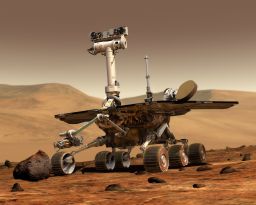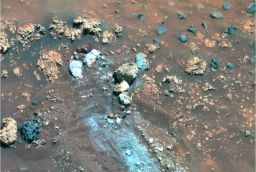A.J.S. Rayl • Jul 31, 2007
Mars Exploration Rovers Update: Opportunity and Spirit Brave Global Dust Storm
It was to be a Martian summer to remember. Just one month ago, the Mars Exploration Rovers were set to embark on long-awaited adventures. At Meridiani Planum, Opportunity was preparing for its grand entrance into the magnificent Victoria Crater and on the other side of the planet Spirit was finally going to explore the top of Home Plate, an old, intriguing volcanic formation in the Gusev Crater area. Then a series of dust storms hit … suddenly, it was a Martian summer to remember alright, but for far different, windswept reasons.
Gusts and skirmishes emanating from different locations around Mars' southern hemisphere sent the planet's powder-fine dust swirling high into the atmosphere throughout the month of July, blotting the Sun and forcing the solar-powered Spirit and Opportunity to stop in their tracks and conserve energy.
Various "dust-lifting events," as MER team members call them, merged to slam Opportunity, sending its power levels crashing to the lowest ever experienced on the mission. Then the cloud of dust spread, effectively pulling a shroud over the planet as winds blew it around the globe to darken Spirit's doorstep and limit operations as Gusev Crater. With only the north and south poles not obscured, NASA's orbiters, Mars Odyssey and Mars Reconnaissance Orbiter (MRO) , and the European Space Agency's Mars Express had little choice but to shift gears from other planned investigations and study the storm.
Spirit and Opportunity were designed to emulate human geologists, not armored survivalists that could withstand a serious seasonal onslaught of Martian dust storms. This month, surviving these dark days became "one of their most significant challenges," Steve Squyres, principal scientist for rover science, said in an interview earlier today. "There's never been a solar-powered vehicle inside a major Martian dust storm before. We are learning now what that means." The answer, of course, is blowing in the winds.
The Mars dusting happened fast and almost without warning. In fact, it was a matter of hours after NASA and MER officials announced the rovers' summer agenda on June 26 that things started to look bad. "It caught us by surprise," Squyres said earlier this month during a break from MER meetings at the Jet Propulsion Laboratory (JPL) where the identical twin rovers were designed and built. In addition to the MER group meetings, Squyres and many of the other Mars scientists in the world dropped in on Pasadena, California for the Colloquium on Astrobiology and Mars Exploration, held early in the month at a local hotel, and the International Mars Conference, held July 9-13 at Caltech, both of which produced a host of stories. But dust was the topic of real concern at JPL. "There's no way you can see this sort of thing coming," Squyres said. "In aircraft flight operations, you can predict the weather. You know when a hurricane is coming. You can't do that on Mars in any operational sense."
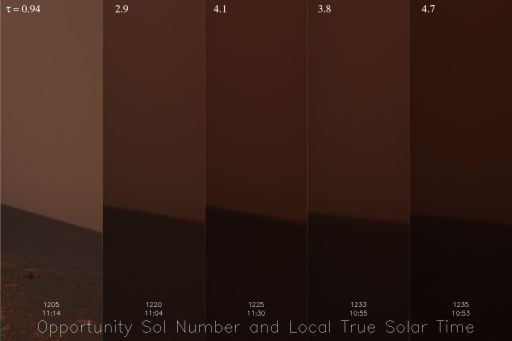 Opportunity's dimming horizon
Opportunity's dimming horizonThe 2007 dust rager seriously darkened Opportunity's skies, robbing it of solar energy. These images -- Jim Bell's Pancam "hit" of the month -- were made from calibrated radiance data, so they show the correct relative brightness of the scene Opportunity observed as the storm developed. The sky is less than half as bright in the last frame as in the first; the ground is 40% as bright. The images for this sequence were taken on Sol 1205 (June 14, 2007), 1220 (June 30), 1225 (July 5), 1233 (July 13), and 1235 (July 15). After the last of these images were taken, Opportunity was forced to stop all science and most other operations, including regular communication with Earth inorder to conserve its battery power and ride out the storm.Credit: NASA / JPL / Cornell
Beyond their unpredictability, Martian dust storms can go for days or weeks or even months and "a fear of the unknown," Squyres said, naturally set in. Weather reports and images from the team handling the Mars Color Imager (MARCI) camera onboard MRO were helping the MER team track the storm and plan rover operations. "But once they told us that there was dust activity particularly close to Meridiani, we started to see the taus rising [dust increasing] at our site for a period of more than a week," Squyres recalled. "It just went up and up and up every day and it got dustier and dustier. All we can do is react to circumstance."
"The storminess -- the major part of this dust event -- started near the Opportunity site," elaborated Mark Lemmon, a planetary scientist and member of the MER science team, who is an associate professor in the department of atmospheric sciences at Texas A&M University. "There were actually several different active centers on Mars kicking up dust both northwest and southwest of Opportunity's site."
As June turned to July, Opportunity's planned descent into Victoria was postponed and the MER team was scaling back operations so the rover could conserve energy. By the end of the first week of July, the dust outbursts near Meridiani Planum were evolving, darkening skies and cooling daytime temperatures as an ever-growing plume moved eastward and toward mid-latitudes.
"The dust came over Opportunity first from the south," said Lemmon in an interview yesterday. "But in the course of that, there were different places where the actual dust-lifting was going on and Opportunity was hit by a few local storms." About a week later, there was a measurable increase in atmospheric dust on the opposite side of the planet at Gusev Crater where Spirit was still at work in the Silica Valley. "Quickly after that, to the south of Opportunity, this series of dust episodes turned into a hemispheric event that spread and went through Hellas and eventually became planet encircling," said Lemmon.
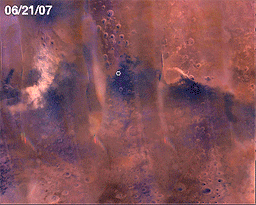 Storm crossing
Storm crossingThis animation -- the handiwork of Glen J. Nagle, the education & outreach manager of the Canberra Deep Space Communication Complex in NASA's Deep Space Network -- from images taken by Michael Malin's Mars Color Imager (MARCI) camera onboard the Mars Reconnaissance Orbiter (MRO) gives you an idea of how the storm moved in on and over Opportunity at Meridiani Planum from late June through mid-July, 2007.Credit: NASA / JPL-Caltech / MSSS / animation by G.J. Nagle
"When something like this first happens, it is scary," Squyres said. "And when you're in an unknown situation like that, you tend to approach it very, very carefully." The one thing he's never worried about is one of the rovers getting blown away – literally. "A lot of things worry me, but that's not one of them. With the Martian atmosphere being extremely tenuous, the dynamic pressure exerted on the vehicle [which weighs approximately 380 pounds] even by very high wind velocities is just not an issue," he explained.
Late in the second week of the month, some data seemed to indicate atmospheric opacity was decreasing, which allowed team members to think that maybe they had weathered "the worst of it," as John Callas, of JPL, MER project manager put it. But the relief was short-lived. The storm found a "second wind." While the team commanded Spirit to start conserving power by limiting its activities, Opportunity, which had already taken the brunt of the dusting winds, took a direct hit mid-month from another dust storm that moved in and "sat" on top of the rover's site, increasing the dust and blocking an estimated 99% of direct sunlight, leaving only limited diffuse sky light for power.
Into the third week of July, both Opportunity -- stationed in Duck Bay off the rim of Victoria Crater -- and Spirit -- parked at Innocent Bystander near the base of Home Plate -- were feeling a loss of energy. As solar-powered rovers, the twin robots rely on sunlight to charge their batteries and keep vital electronic parts warm. The less dust in the atmosphere, the better, because it means more sunlight reaches the rover's solar panels. Mars, however, is a dusty place even when it's not the height of summer and dust storm season. When it is the season, like now, storms like the current one and worse can move in, veil the planet, and block most of the direct sunlight the rovers need for power. Keeping an eye on the dust is exactly why Spirit and Opportunity have been making routine atmospheric observations throughout their missions.
The way scientists estimate the amount of dust in the atmosphere is by measuring optical depth, defined by units of "tau," which go from values of 0 (perfectly clear skies) on up. The lower the tau value, the less dust, the clearer the skies. Tau levels on Mars at this time of year when no dust storms are occurring are, according to Squyres, around 1. Dust events like the one taking place on Mars now, however, can easily raise the tau to 5, which means less than 1% of direct sunlight is reaching the Mars surface, and of course they can go beyond. "The rovers' solar arrays also receive light that is scattered from the dust, so the decrease in power [availability for the rovers] is not as great as it seems," Squyres noted.
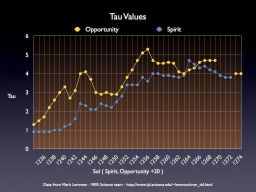 Spirit and Opportunity tau values
Spirit and Opportunity tau valuesFor both rovers, typical values of atmospheric opacity, or tau, hover between 0 and 1. During June and July of 2007, dust storms lofted dust into the atmosphere, increasing the opacity to never-before-seen values above 5. At these levels, less than 1% of the sunlight that impinges on the top of Mars' atmosphere reaches the rovers' solar panels.Credit: Data from Mark Lemmon / Graph by Doug Ellison
It's a good thing. The rovers need to generate some power to keep warm and operate even in a near-dormant state and, importantly, to keep their electronics from getting too cold and breaking. Spirit and Opportunity are each equipped with eight radioactive heaters in addition to electric heaters. While the plutonium-powered heaters help the rovers' survive on low-power days and through extremely cold nights, electric heaters are also needed to keep the batteries and electronics within safe operating temperatures. However, it does take energy to run the heaters.
Beyond darkening the atmosphere, the dust is having an impact on both daytime and nighttime temperatures. "It's cooler by 10 to 20 degrees Celsius [50 to 68 degrees Fahrenheit] than normal during the daytime because less sunlight is hitting the surface, but it's warmer at night than normal," Lemmon pointed out. "The dust blocks infrared light from escaping, as well as blocking sunlight from getting down, which acts something like a blanket. So the dust actually warms the atmosphere. At nighttime, the surface radiates away energy into the dust in the atmosphere and the atmosphere insulates it a little bit," he explained.
Even though it's summer, since they are not currently using their instruments and or roving every day now, the rovers, especially Opportunity, are colder than they would be if they were working and colder than you would think they might be from estimating the outside temperature, said Lemmon. "Everything we're doing up there requires using electronics in the rovers and by using energy the rover keeps warm," he pointed out. "A large fraction of the rovers' heat in them is supplied by doing science or driving or something with the rovers. Now that we're keeping them asleep as much as possible and doing very little actual activity, we're not dumping that energy into the electronics box, so it is colder in the daytime more [in the box] than at the surface, because it is not being used. The amount of cooling is more than you would expect, because of this electronics effect," said Lemmon.
There is a lot of concern right now about Opportunity, because the temperatures have been dropping "about one degree per day" inside the electronics box -- even though it's insulated, expounded Bruce Banerdt, of JPL, MER project scientist. "We really didn't think we'd be hanging around this long and dealing with this kind of dust storm. Now we're in a whole thermal regime we've never seen before and one that the rovers were not particularly designed to handle," he said. "It's hard to predict, when you get to these very low, critical power levels, exactly what the power requirements will be and what the thermal conditions of the planet will be."
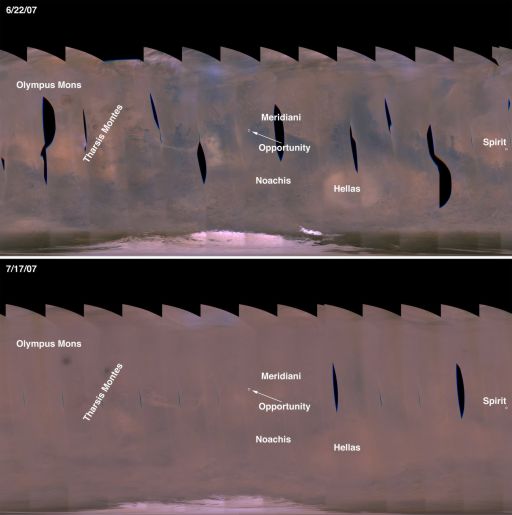 The 2007 global dust event
The 2007 global dust eventDuring June and July 2007, a series of regional dust storms on Mars lofted dust into Mars' atmosphere and obscured the view of the ground. These two maps are mosaics of images captured by Mars Reconnaissance Orbiter's Mars Color Imager (MARCI). The first one, taken on June 22, shows a mostly clear Mars except for a dust storm near the east end of Valles Marineris. The second, taken on July 17, shows a planet obscured by dust raised by numerous local and regional storms. Black gaps in the mosaics occur wherever the orbiter slewed to the east or west to point its other instruments at objects of scientific interest.Credit: NASA / JPL / Malin Space Science Systems
As major an event as this current global dust storm is, it still does not compare to the really big planet shrouding incidents documented in 2001 and 1971. This hardly matters to the rovers or the MER team, though. As the twins headed into the weekend of July 21-22, Spirit was experiencing a tau upwards of 4 and Opportunity, commanded to rest and stay warm, was incommunicado and alone, suffering a tau value the team could only guess was upwards of 5. The "glamour girl" was getting the first, bona fide vacation of the mission and yet the goal was simply to -- survive.
There's nothing quite like a Martian dust storm on Earth. It could loosely be likened somewhat to the dust storm that whipped up around Phoenix, Arizona around the same time [mid-July 2007], but with distinct differences. The Phoenix incident was "a much more localized phenomenon," and "the dust grains much coarser" than dust on Mars, said Squyres. Moreover, there isn't any kind of epicenter or "eye" of the Martian storm as in hurricanes or tornados on Earth. "These things are diffuse," he explained. "A broad region may be affected, but there can be multiple centers of dust-lifting episodes within that, so there is, today, a particularly dense plume at this location and the next day another one has spawned over here. Earth doesn't do this. Mars does this."
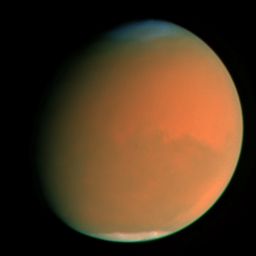 The 2001 global dust storm on Mars
The 2001 global dust storm on MarsA global dust event on Mars in 2001 engulfed the entire planet for more than three months. SourceCredit: NASA, J. Bell (Cornell University), M. Wolff (Space Science Institute), and the Hubble Heritage Team (STScI/AURA)
"There are local and regional storms at different places on Mars that are kicking up dust and that dust is spreading around the planet, merging with dust from other events on the other side of the planet," elaborated Lemmon. Unlike on Earth, however, where the dust or sand is confined to just above the ground, on Mars, it extends 10 to 20 kilometers up, high into the atmosphere, then spreads around. The dust is now covering a large fraction of the planet and obscuring views at every longitude, just not from pole-to-pole. So it is a global dust event, but there's not storminess covering the whole planet."
On Mars, the effect -- if you were standing with the rovers -- according to both Squyres and Lemmon -- is "more like being downwind from heavy smoke from a bad forest fire" than sand, because the Martian dust is "so-fine-grained." This is not like a big storm on Earth where the Sun is completely blocked, Lemmon added. "The rovers can take pictures of the Sun and can still see the disk. There are only 8 hours a day that's true, as the Sun gets low it fades into the murk long before sunset. But at noon, if we take a long enough exposure, we can see the disk of the Sun -- and that's how we directly measure the optical depth, by how much fainter than usual that is."
Although everyone knows Spirit and Opportunity cannot go on forever, no one on the MER team seemed to believe this was their time to go. "We have techniques for managing risk and now we have one more item to add to our list of the risks we manage on a daily basis," said Squyres. "That's really the way to look at it. The real risk from dust storms is that you don't have enough power to fully charge the battery and so it gets depleted too rapidly. We use the battery at night to keep the vehicle warm, but the warmer the environment is the less we need to do that. Since it's summer in the southern hemisphere on Mars right now, it doesn't get as cold at night. The amount of survival power you need in summer is a lot less than in winter. That's one good thing."
The other "good thing" emerges from the bittersweet irony that the Martian winds that giveth dust also taketh it away and both Spirit and Opportunity have received fortuitous gusts of wind that cleared their solar panels of accumulated dust depositions. "They are in great shape right now, the cleanest they've been in a long time," said Squyres. "So the combination of those two factors means that the amount of dust in the atmosphere that it would take to kill these vehicles is more than we're actually seeing. If we see taus of 6 and 7 and 8, then I'll be scared. Can Mars do that? Yeah. Will Mars do that? I don't know. If it does, will we survive? Maybe. Maybe not. We can only react. Yes, this could end the mission and so could dozens of other things. These rovers have been at risk since we launched -- the landings, thermal cycle -- expansion and contraction, the things we ask them to do. There are all kinds of risks on Mars. Dust in the atmosphere is one more."
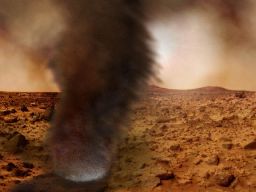 A Martian dust devil imagined
A Martian dust devil imaginedUniversity of Michigan researcher Nilton Renno whipped up this concept of what a dust devil might look like up close on Mars. Spirit snapped its way into the record books on the MER mission by capturing the first ground images of the infamous "devils" in the Gusev Crater area. Scientists are hoping the rovers will be able to teach them more about Martian dust -- in the forms of "devils" and major storms -- and how they relate.
Credit: University of Michigan / N. Renno
True to their MER natures, both rovers came through the July 21-22 weekend "beautifully," Squyres reported. "They were both power positive over the weekend, meaning they were generating more power than they were consuming." Moreover, their batteries were fully charged, a tribute to the JPL engineers and rover handlers, who are "very clever," as Lemmon put it, in finding ways to conserve energy. By planning conservatively and building in healthy margins, when the dust in the atmosphere -- or tau -- does jump and the rover gets less solar power, the batteries will still be in a good state of charge. "We never plan to use all available energy," Lemmon added. "We save a lot of it just in case things change. Being conservative like that is what has allowed the engineers to keep the rovers' batteries nearly fully charged."
"The magnitude and duration of the storms brewing this southern Martian summer are not particularly unusual for this season on Mars," reminded Jim Bell, also of Cornell, the principal investigator on the panoramic camera (Pancam). "What's more unusual is that we somehow 'escaped' all of this dust activity last Martian summer."
Last Martian year featured a much more mild summer dust season and the global dust that did get kicked up from different storms in a lot of different places wasn't "that big of deal," Lemmon chronicled. "We would see optical depths going up to taus almost as high as 2, then, within two or three days, they would start falling again, because it was just one storm that passed over. As soon as the storm was gone, the optical depths recovered, because there wasn't something spread around the globe. Now in this storm season, where we have the planet-circling happening and all this stuff spread around the globe, there's nowhere for the dust to go. If the winds blow the dust away, other winds will blow new dust in."
That means that even when the storm abates, it could be weeks before the air clears. "This is just a volatile time and the dust is fluctuating quite rapidly as thicker parts of the dust cloud get blown in by the wind to our area and then the thicker part gets blown out and a clearer part is blown in, so there is a lot of spatial variation in that it changes given the winds," said Lemmon, who offered up his best foreguess. "I'm expecting to see is the short-timescale variations are going to get lower and lower as the actual dust-lifting diminishes and the dust that's up there spreads out and covers everything. Then we'll just watch the optical depth numbers very slowly return back to normal over the next two months."
The only way to get rid of the dust is to let it slowly settle out. A typical rate, Lemmon said, is something like one percent a day. "So even if all the storms on Mars shut down today, you're talking about two or three months before you're back to normal levels."
In settling out, the dust will likely fall and accumulate on the rovers' solar panels and everything else exposed on the vehicle. "What we gain in illumination, we think we'll loser to dust coating the solar panels," said Banerdt. "We are hoping the cleaning events that have been prevalent the last month will arrive and not be followed by another dust storm." It's that Martian giveth and taketh away thing again.
As for dust on the instruments, Bell, for one, isn't overly concerned about the cameras. "The dust is not particularly dangerous to the cameras," he noted earlier today. "There is the risk of getting dust on the lenses or in the mechanisms for moving the mast, of course, but more than 2500 combined sols of activity suggest that this is not especially 'dangerous,' just a modest concern. We haven't seen any evidence of dust on the Pancam lenses -- at least not enough to obscure the scenery in any measurable way."
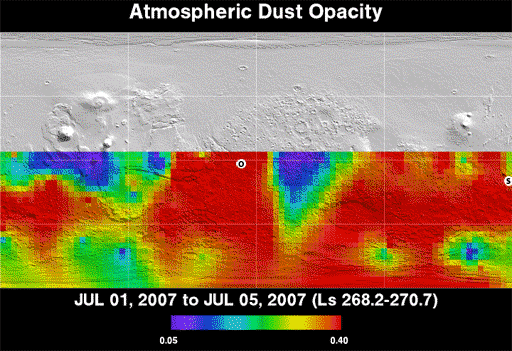 Mars' 2007 global dust event as observed by Mars Odyssey THEMIS
Mars' 2007 global dust event as observed by Mars Odyssey THEMISThis animation is comprised of "dust maps" of Mars captured by the Thermal Emission Imaging System (THEMIS) on Mars Odyssey. The maps show the atmosphere's opacity at an infrared wavelength of 9 micrometers. The scale bar runs from a nearly clear opacity value of 0.05 to 0.40, which represents an approximately two-thirds reduction in the amount of sunlight reaching the ground. For the latest dust maps, visit the THEMIS website. This animation was created by The Planetary Society's own Emily Lakdawalla and will be updated, she promises, as the THEMIS team posts more maps.
Credit: NASA / JPL / Arizona State University / animation by E. Lakdawalla
Going into the final days of the month, the dust levels continued to bounce around high tau values of 4 and 5 and "a little better" turned "bleak" again for both rovers, with the dust hanging over them and not much visible improvement for either Spirit or Opportunity. But by late last week, there seemed to be a general consensus of optimism about the rovers' chances for weathering the storm, even at NASA headquarters. "We should be able to ride it out," offered Ray Arvidson, of Washington University St. Louis, deputy principal investigator for rover science, earlier in the month. On Friday, July 27, 2007, NASA officials made the optimism official, announcing in a press release that they expected the robots are capable of surviving.
As July gives way to August, both Opportunity and Spirit are in relatively storm free areas, "there's just a lot of dust in the sky from storms from other places," said Lemmon. Provided no new storms whip up the Martian dust again, we can expect to see dust "fluctuations" on Mars for a while, he added. "Hopefully they will becoming increasingly minor fluctuations on whatever background we have -- which will probably be up around tau of 4 -- then we'll begin to see a slow decline taking place. Right now at a tau of 4+, we have to be as efficient at keeping things as warm as possible on the rovers. So far it's working. Things are being kept at reasonable temperature and the batteries are nearly fully charged."
The objective now remains keeping both rovers "alive." The plan for coming sols is to "hunker down and survive the dust storm," said Squyres. "We've got places to go and things to do, but they'll have to wait until the dust subsides some." The tau will have to drop to "a value of 3.5 or so," he added, in order for the rovers to start doing some science again.
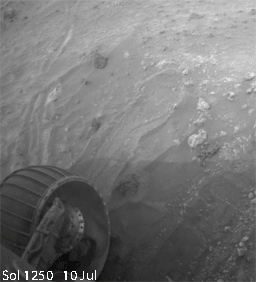 Sand ripples in motion near Spirit
Sand ripples in motion near SpiritEight Hazcam images captured over a period of 17 days show how forcefully the winds are blowing across Spirit in Gusev Crater. In the first image, captured on sol 1250 / July 10, 2007, Spirit's left wheel has left a track in the sand. Over the subsequent sols, wind obliterates the track.Credit: NASA / JPL / animation by Fredk
Spirit is currently faring pretty well, Banerdt reported, with enough energy to continue communications and some minor atmospheric research. Opportunity remains most vulnerable because of the heater switch that has been stuck in the "on" position since landing day in January 2004. "As of Sol 1249 (July 30, 2007), the tau was 4.68 at Meridiani, and the rover eked out array energy of 133 watt-hours and the MER team expects this rover will be draining energy from the batteries over the next few days.
Squyres is maintaining a calm about his charges, particularly Opportunity, the science operations of which he has been overseeing while Arvidson has generally handled those duties on Spirit. "If you would have told me we were going to be hit by a major dust storm, I would have expected to be upset, but I'm finding myself quite relaxed," he said today. "This is Mars. Although there are many ways this mission could end, there are only two acceptable ways for it to end -- one is that we wear them out and the other is that Mars take them out. If you spend enough time on Mars, sooner or later, you are going to experience a dust storm of this magnitude on this surface. We've been fortunate enough to be there 3.5 years and now we're encountering one of these storms."
The latest report from the MARCI team, Banerdt said, indicates that perhaps things are starting to "calm down" a little bit. The chances of it getting worse are "less than 50%," according to an email Bruce Cantor, a MARCI co-investigator, sent out, he added. Better still, there is no new activity around the planet and Cantor is predicting that taus are likely to slowly drop.
Still, it isn't over until it's over, as Yankee catcher and American philosopher Yogi Berra so eloquently underscored years ago, and the MER team will remain ever vigilant until the end. "This is dust storm season and it will go on for several more months," said Squyres. "Mars could do anything to us."
So apparently, could Congress. If Mars wasn't enough of a challenge, the rovers are now facing a death threat down here on Earth, as a bill wending its way through the Senate threatens to shut down the rovers and pull the funding plug. It's part of the continued budget cuts from the science programs at NASA to fund the return to the Moon announced by Pres. Bush in January 2004 as part of his new Vision for Space Exploration.
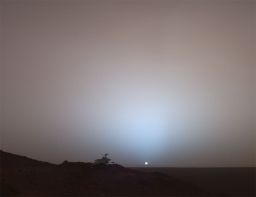 Spirit at sunset
Spirit at sunsetThis FX or created image of Spirit on top of a rock called Jibsheet was produced using "Virtual Presence in Space" technology, developed at the Jet Propulsion Laboratory, where the rovers were designed and built. This technology combines visualization and image-processing tools with Hollywood-style special effects to create an image comprised of a photorealistic model of the rover and a false-color mosaic. The size of the rover in the image is approximately correct and was based on the size of the rover tracks in the mosaic. The mosaic was assembled from frames taken with the panoramic camera on Sol 489(May 19, 2005).
Dan Maas created the MER model; synthetic image by Koji Kuramura, Zareh Gorjian, Mike Stetson and Eric M. De Jong.Credit: NAA / JPL-Caltech / Cornell
"We're looking into this," Squyres said. "But I can tell you I have been working on this thing for 20 years now. We have faced threats far greater than this dust storm and we have faced threats far greater than whatever's going on in Congress right now and we have survived those. Will we survive the dust storm? I don't know. We'll see. But when you've been at it this, this long, you take it in stride and don't let yourself get too perturbed with the sol-to-sol and week-to-week fluctuations," he said. "It'll just make you crazy if you do. You learn to roll with it."
As clear as the Martian sky is dusty now, the month of July will surely go down in the notebooks of these two dynamic robot field geologists as dark days. For the moment, however, Squyres is focused on the support. "There are people all over the world pulling for these rovers right now," he said today. "I -- we -- all of us working on this really appreciate the feelings, positive communications, the calls and emails we've gotten from so many people pulling for the rovers to come through this okay. In fact, Ray Arvidson just came back from China [where he was consulting with the Chinese lunar program] and he sent me an email this morning saying that even in some remote parts of the country the news media were telling the story of 'the brave little rovers.' These are robots, hunks of metal, but people have personified to them to a considerable degree and it's not hard to identify with these two little things so far from home, struggling to survive this storm. We've got a lot of confidence in these rovers. Maybe it's misplaced, but we're in the process of finding out right now how tough they really are," he said pausing.
"I've always known the vehicles are not immortal," Squyres said, picking up his thought. "It's going to end sometime. They've gone on far longer than I expected and they've gone beyond our wildest dreams. I feel okay. Right now, I'm waiting to see what happens just like everybody else."
Spirit From Gusev Crater
As July began, Spirit was in the midst of finishing up its work in the Silica Valley, specifically studying a cluster of rock fragments dubbed Innocent Bystander. The target was named when the rover accidentally ran over it and broke it up while it was attempting to crush another rock, Virginia Bell, to expose a fresh surface for examination.
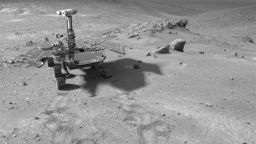 Spirit in the Columbia Hills
Spirit in the Columbia HillsThis FX or manufactured image of Spirit in the Columbia Hills was also produced using "Virtual Presence in Space" technology, combining a photorealistic model of the rover and an image taken by Spirit with its navigation camera on Sol 438(March 27, 2005). The size of the rover in the image is approximately correct and was based on the size of the rover tracks in the navigation-camera image.
Dan Maas created the MER model; synthetic image by Koji Kuramura, Zareh Gorjian, Mike Stetson and Eric M. De Jong.
Credit: NASA / JPL-Caltech
It was, it turns out, another fortuitous accident for Spirit, because the data shows that Innocent Bystander may have been formed by either a fumarole or hot spring, something of great interest to MER geologists because it directly points to water. A fumarole is a vent in the Earth's surface that emits steam and volcanic gases. Volcanic gases leach the original rock and leave silica-rich rock behind. If Innocent Bystander was created in a hot spring environment, then it could be siliceous sinter, a kind of silica-rich rock that precipitates directly from water.
With reports from Meridiani, Spirit turned much of its attention in the first week of the month on atmospheric work, expanding its routine observations, as well as continuing with its two communication sessions, the morning direct-from-Earth uplinks via the rover's high-gain antenna and evening downlinks at UHF frequencies via the Mars Odyssey orbiter.
On Sol 1242 (July 1, 2007), Spirit measured atmospheric dust opacity and took pictures of the external calibration target, acquired photometric data looking east toward the equator, north (directly) toward the equator, and west toward the equator, and snapped some thumbnail images of the sky with its Pancam. The rover continued atmospheric observations the following sol, making multiple measurements of atmospheric dust opacity at different times of day with the Pancam, surveying the ground and sky at different elevations using the miniature thermal emission spectrometer (Mini-TES), and surveying the sky at low Sun with the Pancam.
Spirit added some science observations to the mix on Sol 1244 (July 3, 2007), including taking movie frames with the navigation camera in search of dust devils and acquiring a 2x1x7 panorama of stereo microscopic imager (MI) pictures of Eileen Dean, one of the silica-rich soil targets in the Silica Valley. The rover changed tools to the Mössbauer spectrometer and then checked for the iron content of Eileen Dean, and later acquired full-color Pancam images of a target known as Sorak and of the ever-popular El Dorado dune field. And, after once again measuring atmospheric opacity with the Pancam and scanning the sky and ground with the Mini-TES, the rover also managed to get in a survey of Sorak and a target known as Palthon2 with the Mini-TES, acquire more photometric measurements with the Pancam, and take a mosaic of images of the Sun with the navigation camera.
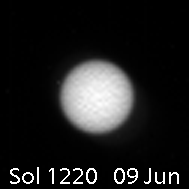 Spirit's dimming Sun
Spirit's dimming SunSeveral times a sol, the Mars Exploration Rovers take images of the Sun (using a very dark solar filter) to determine the opacity of the atmosphere (a property that is referred to as "tau"). Here, images of the Sun taken by Spirit since Sol 1220 (June 9, 2007) have been calibrated to show how dim the Sun appeared through the dust storm.Credit: NASA / JPL / Cornell / animation by E.Lakdawalla
While Americans celebrated Independence Day, Spirit spent Sol 1245 (July 4, 2007), keeping watch on the dust levels at Gusev Crater, continuing to measure atmospheric opacity at different times of day, take photometric observations with the Pancam, snap images of the Sun with the navigation camera, and survey the ground and sky at different elevations with the Mini-TES. But the rover also packed in more science by re-starting the Mössbauer spectrometer for continued iron analysis of Eileen Dean, acquiring full-color Pancam images of Palthon2, and surveying targets dubbed Sorapus and Manitalia with the Mini-TES.
On the following sol, Spirit looked for the mineral content in a target called Naomi Meier and checked for changes in measurements of darkness with the Mini-TES. In addition to collecting more measurements of atmospheric opacity and surveying the surroundings with the Mini-TES, Spirit acquired stereo MI pictures of the target called Eileen Dean2, then switched tools to the alpha-particle X-ray spectrometer (APXS) and placed that instrument on the target before taking a nap. On re-awakening, the rover continued to measure atmospheric opacity and survey the surroundings, then took another nap, waking up at 11:10 p.m. local Mars time to a 12-hour APXS analysis of Eileen Dean2.
After checking out the atmospheric dust again on Sol 1247 (July 6, 2007), Spirit stowed the robotic arm and drove closer to Innocent Bystander. Along the way, it acquired mid-drive, full-color images of the work volume the Pancam, as well as images with the hazard avoidance cameras. After transmitting data to the Odyssey orbiter, the rover again measured atmospheric dust and took images of the Sun with the navigation camera.
Even before the second week of the month began, the story at Gusev turned pretty much to all dust, all the time, with Spirit using most of its worktime for the rest of the month in dust monitoring mode, checking accumulations of the Martian powder on the mast, surveying the horizon with the Pancam, and taking surveys at high Sun. The rover did manage to sneak in some time, however, to watch for dust devils.
On Sol 1250 (July 10, 2007), Spirit drove up to Innocent Bystander, acquiring the usual post-drive images with the hazard avoidance cameras and a 360-degree panorama with the navigation camera. The next sol, the rover continued its atmospheric observing ritual at multiple times throughout the sol, and completed a survey of clasts using the Pancam. The rover then unstowed its instrument deployment device (IDD) or robotic arm and acquired a 2x1x7 mosaic of close-up, MI pictures of Innocent Bystander, then placed the APXS on the silica-rich target and continued with its dust watch. The rover stretched out its sol once again, napping, then waking at 11:10 p.m. local Mars time to begin another APXS study that was to last just under 12 hours.
Even though tau had been trending upward during the second week of the month, Spirit's solar power levels had risen only slightly, because of the recent wind-related cleaning of the solar panels. On Sol 1252 (July 12, 2007), Spirit once again was hit with Martian gusts that cleared her solar panels, and her power levels moved into the high 300 watt-hours.
Spirit continued to do well going into the third week of the month. By Sol 1257 (July 17, 2007) the tau value at Gusev decreased from 3.8 to 3.6, with solar array power on the rover registering around 385 watt-hours. But the weather predictions for the area suggested things could get worse again. Almost as if on cue, the tau rose to 3.96 at Gusev on the very next sol, a new high for Spirit -- and yet more wind gusts arrived to clear the solar array. That dust-cleaning event offset the energy reduction due to the higher tau, giving the rover a power level of 366 watt-hours. Nevertheless, the MER team uplinked a scaled-back plan of operations to Spirit, configuring the rover with many of the same low-power settings as Opportunity, although it was commanded to maintain more frequent communication and some atmospheric observations, as power permitted.
Spirit's weekend plan -- with extra margin built-in -- assumed that tau would increase to 4.5 then to 5.0 at Gusev over Sols 1261-1262 (July 21-22, 2007); therefore, the rover's agenda stayed simple: maintain daily communication and only perform very limited atmospheric measurements. By Sol 1263 (Monday July 23, 2007), the tau value at Gusev dropped slightly to just below 4.
 Home Plate from above
Home Plate from aboveThis image of Home Plate and Mitcheltree Ridge was taken by the Mars Reconnaissance Orbiter's High Resolution Imaging Science Experiment (HiRISE)camera on November 22, 2006. North is at the top and the path followed by the rover Spirit is shown.Credit: NASA / JPL-Caltech / Univ. of Ariz.
Two sols later, on Sol 1265 (July 25, 2007) the tau was back up to 4.7 and Spirit, with 261-watt-hours of power, headed into the final days of July under the dustiest conditions it had ever experienced. It was not as ominously dark and foreboding as it was at Meridiani in the worst of the dust fest, but it wasn't any healthier for the rover either
In addition to sporting clean solar arrays, one thing that helped Spirit in the midst of all this, Squyres pointed out, is that it is positioned at 16 degrees south latitude. "We're right in the depths of southern summer right now, so Spirit gets more sunshine this time of year, because the Sun goes straight overhead at that site," he noted. "Generally, in the winter Opportunity does much better. But in the dead of summer, Spirit gets more power."
During the past week, Spirit has continued to experience tau values over 4, with its solar power output hovering around 270 watt-hours. Still parked at Innocent Bystander, the rover is "able to do some work but not much," Arvidson said.
The tau level at Gusev was around 4.3 or so, yestersol, Sol 1270, (July 30, 2007) and the rover's power level was about 275 watt-hours, high enough so that it was able to conduct some dust analysis. "It's warmer at the Spirit site, so temperature is not an issue," Banerdt pointed out. "And the solar panels are a little bit cleaner than on Opportunity, so it's getting almost twice the amount of energy," he said.
In coming sols, power permitting, the rover will be taking a look at some surface features to search for change, he added. "Other than that, it's just waiting out the dusty skies until the opacity goes down and the energy goes up."
Opportunity from Meridiani Planum
As the calendar flipped to July, Opportunity broke its dust record, with the tau level rising at Meridiani Planum from 1.0, about average for this time of year, to 3.3, initiating a deep power drop 765 watt-hours to 402 watt-hours over the same period of time. "While this only represents enough dust to coat the planet to about the thickness of a human hair, it is enough to decrease the brightness of the noon Sun by 96 percent compared to a completely clear atmosphere," Squyres said in an official press release. When dust reduced the panels' daily output to less than 400 watt-hours, the MER team suspended driving and most science observations, including use of the robotic arm, cameras, and other instruments. And, the rover's grand entrance into Victoria Crater was postponed to "no sooner than July 13," John Callas, MER project manager, announced.
Opportunity spent the first week of July -- from Sols 1220 to 1226 -- conducting minimal atmospheric dust monitoring observations with the Pancam and conserving power. On Sol 1223 (July 4, 2007), the rover did celebrate some independence as it successfully recovered from the robotic arm joint stall that occurred back on Sol 1217 (June 28, 2007). It used the microscopic imager (MI), then retracted its instrument deployment device (IDD), an action it confirmed by taking a picture of it with the navigation camera. It then closed the MI dust cover and again confirmed this step with another picture.
As the dust fluctuated up and down around Meridiani, the outlook ranged from bleak to really, really bad for Opportunity. Just when it looked like the storm might have blown itself out, on Sol 1235 (July 16, 2007), a cloud moved in from the west again and "just kind of sat on top of Opportunity with dust-lifting happening right there," said Lemmon. "It wasn't a very big storm, but that's when we saw our worst optical depth [tau] -- which I estimated to be around 5.3."
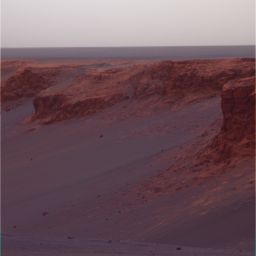 Before the storm
Before the stormOpportunity took this Pancam image from its current position off the rim at Duck Bay, Victoria Crater in the early days of July just before the team commanded her to suspend science operations. In the hours following, the skies darkened with dust and the rover hunkered down to wait out the storm.
Credit: NASA /JPL-Caltech / Cornell
On Sol 1236, which ended Tuesday (July 17, 2007), Opportunity used more energy than its solar panels could generate on that sol, drawing down its battery. The team sent up a very low power plan via the X-band link on Sol 1237, but it didn't get through to the rover. There was indication that its communication hardware was too cold. The increased tau influenced the temperatures on the hardware, which affect the equipment frequency response, thus making accurate temperatures very difficult for the ground team to estimate. Normally a frequency offset is added to the X-band communication session to compensate. In this case, however, the colder than expected temperatures required a larger frequency offset and without that offset, the Sol 1237 uplink did not achieve signal lock. The team did, however, received a UHF pass with data that indicated the rover was negative on power – meaning it was using more power than it was taking in – and also suggested the tau had increased above a value of 5 the sol before. Opportunity's solar panels dropped to 148 watt-hours, the new lowest point for either rover.
On the following sol, since Opportunity had not yet received the very low power plan, its energy dropped even lower, to only 128 watt-hours as the tau rose to what Lemmon and others guessed was upwards of 5. "But there's a real uncertainty range," Lemmon qualified. "Part of that is that once we started taking measurements again, there was a big disconnect between the tau measurement and the estimate from the solar arrays, just because of the fact there was more dust on the solar arrays than there had been a week earlier or so. When you're just looking at the arrays, you can't tell whether the dust is in the sky, on the arrays, or both," explained Lemmon.
The X-band session on Sol 1238 (July 18, 2007) used a 5 kHz offset and the rover was able to pick it up, respond, and boost its energy to 191 watt-hours becoming power neutral by the end of that sol. To minimize further the amount of energy Opportunity was using, the commands mission controllers had instructed the rover to refrain from communicating with Earth on Sols 1239 and 1240, (Thursday and Friday, July 19-20, 2007), marking the first time either of the rovers has been told to skip communications for a day or more in order to conserve energy. The team would uplink some maintenance items on Friday, July 20, but would not look for another downlink until Monday morning, July 23, 2007. Opportunity was on its own, forced on a summer "vacation." If rovers could write, the essay on how it spent that summer vacation might be a real page-turner . . . all this devoted, lonely little explorer had to do was . . . survive . . . on a harsh, desolate planet far, far away.
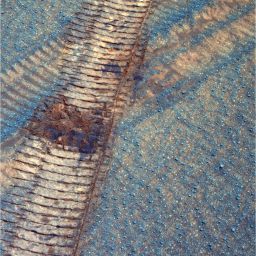 Tracks upon tracks
Tracks upon tracksOpportunity did get a few science images in this month. It took this false color image with its Pancam on Sol 1232 (July 13, 2007) of fresh, new track superimposed on many months-old, degraded ones. "Erosion really works on Mars, too," noted Jim Bell, Pancam lead.Credit: NASA / JPL - Caltech / Cornell
Despite the odds and true to its MER nature, Opportunity pulled through the July 21-22, weekend and even managed to bank a little bit of power as the tau dropped down into the 4 value range. But it wouldn't stay there. Instead, it would continue to fluctuate up and down for the rest of the week despite news that the atmospheric opacity appears to have moderated some.
Although Opportunity had a dust-cleaning event sometime prior to Sol 1235 (July 16, 2007) and its solar arrays were very clear for a while, last Monday, Sol 1243 (July 23, 2007), the arrays had become "significantly dustier," said Lemmon. Nevertheless, they were cleaner than they had been at various points in the mission and operating under the new lower power plan, the rover was expected to be able to keep loads around 130 watt-hours per sol.
As of yestersol, Sol 1250, the tau value at Meridiani was back up to 4.7. "It was dancing around there over last weekend, but the array energy numbers for this sol are 130 watt-hours, the second worst we've seen," said Lemmon. "That's a lot less than what we saw previously at the same tau value. In making these comparisons, however, you have to consider that when we talk about the tau now it's usually an instantaneous measurement. The rover wakes up, snaps a picture of the Sun, we see the optical depth at that moment, then the rover goes back to sleep. The arrays are obviously sensitive to an average of the tau over the day and it's changing a lot," he pointed out.
Moreover, Opportunity, as part of the latest lowest power plan, is instructed now to only downlink data once every 3 days. Therefore, it's going to be hard to know exactly what's going on with Opportunity or at Meridiani until the rover gets back "online" and working.
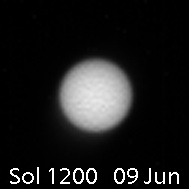 Opportunity's dimming sun
Opportunity's dimming sunSeveral times a sol, the Mars Exploration Rovers take images of the Sun (using a very dark solar filter) to determine the opacity of the atmosphere (a property that is referred to as "tau"). Here, images of the sun taken since sol 1200 of Opportunity's mission have been calibrated to show how dim the Sun appeared through the dust storm. For sols 1236-1242 (July 16-22, 2007), the skies were so dark that Opportunity could not muster enough power to perform its usual tau measurements.Credit: NASA / JPL / Cornell / animation by Emily Lakdawalla
The concern now is keeping Opportunity and its electronics box, warm and keeping the rover from draining the batteries. "The spec is -40 Celsius for operating these electronics – that's what they were tested for," said Banerdt. "So when the temperature reaches about -39 degrees C, the heaters will automatically kick on and those will take 60 watts of power. If the heaters run for any appreciable amount of time, they will run the batteries down."
Consequently, the MER team has commanded Opportunity to stay on a little longer at night just so the electronics are sitting there generating a little bit of heat, "in hopes we can keep it above the threshold of where the heaters would kick in," said Banerdt.
"The question is how long do the conditions have to be this bad before we trip our fault protection software?" said Squyres. "If we trip that, we go into low power mode, a mode where the vehicle basically will sleep all the time, except for 20 minutes a day where it will listen for signals from Earth. It's a strictly survival mode." This part of the fault protection software, the "brain parts" that are uniquely designed for every mission to provide for the safety of the vehicle in the event that something goes seriously wrong. "It's a set of behaviors on the vehicle intended to keep the vehicle safe – think of them as lower brain functions, very simple behaviors and there are different modes for different situations," he explained.
One of the MERs fault protection modes is low power mode -- "which we have not gotten into," Squyres continued. "We have dramatically scaled back operations so we use a lot less power, but that's not low power mode in the formal fault protection sense of that term. The only way Opportunity is going to enter low power mode is if it senses its power system is depleted enough that it decides on its own to do this."
If the rover goes into low power mode it will take certain steps. "One of those steps is that it will no longer transmit to us at all, but open a window once a day for 20 minutes to receive only," Squyres said. "Transmitting data requires a lot of power; whereas, sitting there with the receiver on doesn't require a lot of power. We know where those windows would be, so if we choose to send commands then the rover would receive and act on those commands. But we wouldn't want to do that unless we were sure the rover had enough power to respond appropriately to the commands we sent."
The MER team is expecting Opportunity to be energy-negative or, in other words, draining energy from its batteries over the next few days unless the dust conditions get better. "We're hoping that drain will be low enough so the batteries maintain enough charge to keep them operating," said Banerdt. "Obviously, it makes us all pretty nervous being in a condition like this with so many variables we don't even know about."
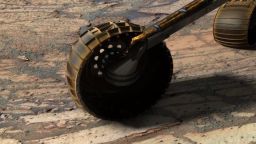 Rove on, Opportunity
Rove on, OpportunityThis rendered image of Opportunity is yet another image produced using "Virtual Presence in Space" technology, developed at JPL. It combines a photorealistic model of the rover and a false-color mosaic taken by the rover on Sol 134 (June 9, 2004) with its panoramic camera while in Endurance Crater. We at The Planetary Society liked it for the symbolism it imparts of the robots that just wanna rove.
Credit: NASA / JPL-Caltech / Cornell
Rover model by Dan Maas, synthetic image by Zareh Gorjian, Koji Kuramura, Mike Stetson and Eric M. De Jong.
One variable they do know is that Opportunity is running on empty when it comes to energy. The most recent numbers from the rover, from Sol 1249 (July 30, 2007), revealed the rover only had 133 watt-hours of energy. "That's right on the edge," noted Banerdt. "It's very possible it could kick into low power fault mode. We've done everything we can to prevent it from triggering that, but we'll find out Thursday."
If Opportunity does, by chance, drain its batteries, though, it could still be revived, Squyres said, and there's even a fault protection for loss of the mission clock by which the rovers schedule their lives and work. "But if it drains the batteries and power goes down to zero, then basically we'll be at the mercy of the Martian environment in terms of what temperatures the rover and the instruments will experience."
"We do have pretty strong expectations that even in the case of a power fault we should still have a rover when the weather gets better," agreed Banerdt. "These are pretty hardy machines, designed to wake up if they power down in bad condition and when conditions get better start talking to us again. But we'll be crossing our fingers for sure."
In reflecting on the last several weeks, Squyres typically put things in perspective. "No one's ever known what it's like to be in one of these storms," he said. "We're lucky we've lasted long enough to experience this. We may come out the other side and we may not. If we do come through the other side -- okay, it's going to be one more phenomenal accomplishment for the mission. If we don't, well, this is one of the two acceptable ways for the rovers to go."
That doesn't mean Squyres -- or any other members of the team -- wouldn't miss Opportunity or Spirit, but that's another story for another time.
For all the MER Updates, go to: http://www.planetary.org/explore/space-topics/space-missions/mer-updates/
Support our core enterprises
Your support powers our mission to explore worlds, find life, and defend Earth. You make all the difference when you make a gift. Give today!
Donate

 Explore Worlds
Explore Worlds Find Life
Find Life Defend Earth
Defend Earth


